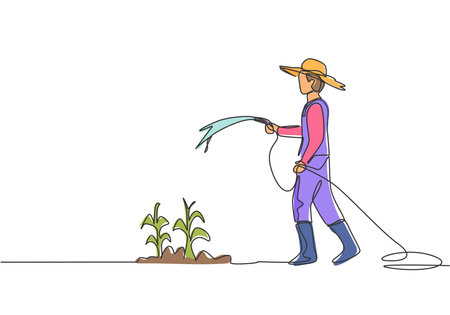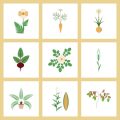1. Understanding Your Gardens Water Needs
Before you grab the hose or turn on the sprinkler, its important to understand that not all gardens—and not all plants—need the same amount of water. Factors like plant type, soil condition, and even where your garden is located can make a big difference in how much and how often you should water.
Different Plants, Different Needs
Some plants love moisture, while others prefer drier conditions. For example, vegetables like tomatoes and cucumbers need consistent watering to produce well, while succulents and lavender thrive with less frequent watering. Here’s a quick look at typical plant water needs:
| Plant Type | Watering Frequency |
|---|---|
| Succulents & Cacti | Every 10–14 days |
| Herbs (e.g., rosemary, thyme) | Every 5–7 days |
| Vegetables (e.g., tomatoes, peppers) | Every 2–4 days during hot weather |
| Flowering Annuals (e.g., petunias) | Every 2–3 days |
Soil Types Matter
Your soil plays a huge role in how water is retained or drained. Sandy soils drain quickly and may need more frequent watering. Clay soils hold moisture longer but can become compacted and poorly aerated. Loamy soil, which is a mix of sand, silt, and clay, is ideal for most gardens because it holds moisture well without becoming soggy.
| Soil Type | Water Retention | Watering Tip |
|---|---|---|
| Sandy Soil | Poor (drains quickly) | Water more frequently in smaller amounts |
| Clay Soil | High (holds water longer) | Water less often but more deeply |
| Loamy Soil | Moderate (balanced drainage) | Ideal; adjust based on plant needs |
The Role of Microclimates
A microclimate is a small area within your garden that has slightly different conditions than the surrounding space. For instance, a shaded corner behind your garage may stay cooler and damper than a sunny spot by the driveway. These differences affect how much water plants need in those areas. Be sure to observe how sun exposure, wind, and shade affect each part of your yard so you can adjust your watering routine accordingly.
Quick Tip:
If youre unsure whether your garden needs water, do the finger test—stick your finger about 2 inches into the soil near your plants. If it feels dry at that depth, its time to water.
2. How Much Water Is Enough?
When it comes to watering your garden, more isnt always better. Giving your plants the right amount of water helps them grow strong roots, prevents disease, and saves you money on your water bill. Heres how to figure out how much water your garden really needs.
Understand Your Plants Needs
Different types of plants have different watering requirements. For example, vegetables and flowering plants usually need more water than drought-tolerant shrubs or native plants. Check plant tags or talk to your local garden center for specific advice on what each plant in your garden prefers.
The Inch-Per-Week Rule
A general rule of thumb for most gardens is that they need about 1 inch of water per week, including rainfall. This can vary based on climate, soil type, and the kinds of plants youre growing.
| Plant Type | Water Needed Per Week |
|---|---|
| Lawn Grass | 1 to 1.5 inches |
| Vegetables | 1 to 2 inches |
| Drought-Tolerant Plants | 0.5 inch or less |
| Newly Planted Trees/Shrubs | 2 to 3 inches (first few weeks) |
How to Measure Water
You don’t need fancy tools to measure how much water your garden is getting. Use a rain gauge or even an empty tuna can placed in the garden. After watering, check how much water has collected in the can—if its around 1 inch deep, youve hit the sweet spot.
Soil Matters Too
Your soil type affects how much water it holds and how fast it drains. Sandy soil dries out quickly and may need more frequent watering. Clay soil retains water longer but can become compacted and suffocate roots if overwatered. Loamy soil is ideal because it holds moisture without becoming soggy.
| Soil Type | Watering Frequency |
|---|---|
| Sandy Soil | More often, less water each time |
| Clay Soil | Less often, more deeply |
| Loamy Soil | Balanced—deep watering once or twice a week |
Avoid Overwatering
If you see yellowing leaves, moldy soil, or root rot, your plants might be getting too much water. Its better to water deeply and less frequently than to give small amounts every day. Deep watering encourages roots to grow deeper into the soil, making plants stronger and more drought-resistant.
A Quick Tip:
If the top 2 inches of soil are dry when you stick your finger into it, its probably time to water.

3. How Often Should You Water?
Knowing how often to water your garden can make a big difference in plant health and water efficiency. Different types of gardens—and even different seasons—require different watering schedules. Here’s a simple breakdown to help guide your routine.
🌿 General Guidelines Based on Garden Type
Each type of garden has its own needs. Heres a quick reference table:
| Garden Type | Spring | Summer | Fall |
|---|---|---|---|
| Vegetable Garden | 2-3 times/week | 3-5 times/week | 1-2 times/week |
| Flower Beds (Annuals) | 2 times/week | 3-4 times/week | 1-2 times/week |
| Perennials | Once/week | 1-2 times/week | Once/week or less |
| Lawn (Cool Season Grass) | 1-2 times/week | 2-3 times/week | Once/week |
| Lawn (Warm Season Grass) | N/A (dormant) | 1-2 times/week | N/A (dormant) |
| Shrubs & Trees (Established) | Every 10–14 days | Every 7–10 days | Every 10–14 days |
🌞 Seasonal Adjustments Matter
Spring:
The weather is usually mild, so plants are just waking up. Start slow and adjust based on rainfall and temperature changes.
Summer:
This is the season when most plants need the most water due to heat and longer days. Increase frequency, but always check soil moisture first to avoid overwatering.
Fall:
The weather starts cooling down, and many plants begin going dormant. Reduce watering gradually to match the plants slowing growth.
💧 Pro Tip: Check Soil Moisture First
No matter the season, always check the soil before watering. Stick your finger about an inch into the soil—if it feels dry, its time to water; if its still damp, hold off for a day or two.
Note:
Your local climate, rainfall patterns, and soil type can affect how often you should water. Use this guide as a starting point and adjust based on your garden’s specific conditions.
4. Best Time of Day to Water Your Garden
Knowing the right time of day to water your garden can make a big difference in the health and productivity of your plants. Timing affects how much water is absorbed, how much evaporates, and whether your plants stay healthy or become prone to disease.
Morning vs. Evening: What’s Better?
The best time to water your garden is early in the morning, ideally between 5 a.m. and 9 a.m. During this time, temperatures are cooler and winds are usually calm. This allows water to soak into the soil and reach plant roots before it can evaporate.
Watering in the evening is your second-best option if mornings aren’t possible. However, there’s a higher risk that moisture will sit on leaves overnight, which can encourage fungal growth and other diseases.
Comparison: Morning vs. Evening Watering
| Time of Day | Pros | Cons |
|---|---|---|
| Morning (5 a.m. – 9 a.m.) | – Less evaporation – Water reaches roots efficiently – Leaves dry quickly, reducing disease risk |
– Requires earlier start to the day |
| Evening (6 p.m. – 8 p.m.) | – Cooler temperatures reduce evaporation – Convenient for many people after work |
– Leaves may stay wet overnight – Higher chance of fungal diseases |
Avoid Midday Watering
Try to avoid watering during the heat of the day—usually between 10 a.m. and 4 p.m.—especially in summer. High temperatures cause water to evaporate quickly, meaning less moisture gets to your plant roots where it’s needed most.
Quick Tips:
- Use a timer or set an alarm to water early in the morning.
- If using sprinklers, run them before sunrise to avoid wet leaves during hot sun exposure.
- If you must water in the evening, aim for just after sunset when temps cool down but leaves still have time to dry.
By choosing the right time of day to water, you’ll help your garden thrive while conserving water and reducing plant stress.
5. Signs of Overwatering and Underwatering
Giving your garden the right amount of water is key to healthy plants, but how do you know if youre watering too much or too little? Here are some common signs to help you identify whether your plants are getting what they need — and how to fix it if theyre not.
Common Symptoms
Use this table to spot the differences between overwatered and underwatered plants:
| Signs | Overwatering | Underwatering |
|---|---|---|
| Leaves | Yellowing, soft, or wilting despite wet soil | Crispy, dry, or curling at the edges |
| Soil | Soggy, stays wet for a long time | Dry, pulling away from pot or ground edges |
| Roots | Mushy, may smell rotten (root rot) | Brittle, thin, may stop growing |
| Growth | Stunted growth, mold or fungus on soil surface | Slow growth, leaves may drop prematurely |
How to Adjust Your Watering Routine
If Youre Overwatering:
- Check drainage — make sure pots have holes and soil isn’t compacted.
- Let the top inch of soil dry out before watering again.
- Water less often but deeply when needed.
If Youre Underwatering:
- Increase how often you check soil moisture — especially in hot weather.
- Add mulch to help retain moisture in garden beds.
- Water thoroughly so moisture reaches the roots — don’t just wet the surface.
Quick Tip:
The best way to check if your plant needs water? Stick your finger about an inch into the soil. If it feels dry, its time to water. If its still moist, wait another day or two before checking again.
6. Efficient Watering Tips and Tools
Using water wisely in your garden not only helps conserve a precious resource but also keeps your plants healthier. Here are some practical ways to water more efficiently while ensuring your garden thrives.
Mulching: Keep Moisture Where It Belongs
Mulch is one of the simplest and most effective tools for water conservation. By adding a 2–3 inch layer of organic mulch (like shredded bark, straw, or leaves) around your plants, you help reduce evaporation, regulate soil temperature, and suppress weeds that compete for water.
Benefits of Mulching
| Benefit | Description |
|---|---|
| Reduces Evaporation | Keeps moisture in the soil longer |
| Suppresses Weeds | Lowers competition for water and nutrients |
| Improves Soil Health | Adds organic matter as it breaks down |
Drip Irrigation: Direct Water Where Its Needed
Drip irrigation systems deliver water slowly and directly to the base of each plant. This method minimizes runoff and evaporation compared to overhead sprinklers. Drip systems are ideal for vegetable gardens, flower beds, and even container plants.
Why Choose Drip Irrigation?
- Saves water by targeting roots directly
- Reduces fungal diseases by keeping foliage dry
- Works well with timers for consistent watering schedules
Soil Moisture Sensors: Know When to Water
If youre not sure when your garden needs watering, a soil moisture sensor can take out the guesswork. These handy tools measure how wet or dry your soil is so you can avoid overwatering or underwatering.
Types of Soil Moisture Sensors
| Sensor Type | Description |
|---|---|
| Analog Sensors | Simple dial indicators; easy to use for home gardeners |
| Digital Sensors | Provide precise readings; often include display screens or apps |
Bonus Tip: Water Early or Late in the Day
To prevent water loss through evaporation, try to water your garden early in the morning or later in the evening when temperatures are cooler and winds are calmer.


